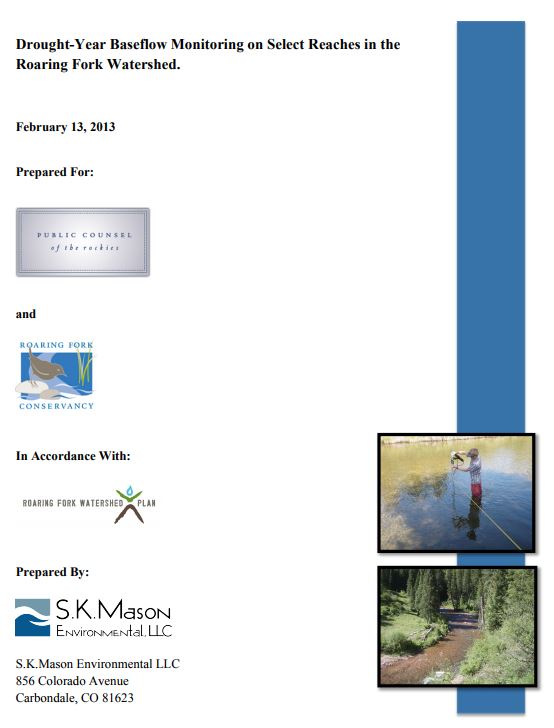SUMMARY
During the fall of 2012, Friends of Rivers and Renewables (FORR), an initiative of Public Counsel of the Rockies, and the Roaring Fork Conservancy (RFC) initiated an effort to periodically collect streamflow data on eight stream reaches previously identified as candidates for permanent streamflow gauge installation. This work aimed to characterize baseflow hydrological conditions on the selected study reaches and assess the adequacy of existing streamflow gauging infrastructure or watershed modeling techniques to inform stakeholder groups on those conditions. Importantly, the data and discussions presented in this brief should be considered within the context of the ongoing efforts of FORR, RFC and others to enhance the availability and effectiveness of hydrological data collected across the Roaring Fork Watershed.
Reach selection for this work followed from the findings of the Stream Gauge Needs Assessment Workshop, hosted by FORR and RFC in April 2012, and a subsequent report, Site Recommendations for Stream Discharge Gaging on Top Tier Priority Reaches in the Roaring Fork Watershed, (S.K.Mason Environmental, LLC, 2012) that further refined potential gauging locations. The Stream Gauge Needs Assessment Workshop identified the need for better information on streamflow to aid resource management decisions regarding water quantity and quality on select stream reaches across the watershed. These reaches were termed top tier reaches. The availability of stream discharge data from state and federal agencies or the need of further stakeholder engagement before proceeding with plans to install new gauging infrastructure led to the removal of several reaches from the top tier list. Reaches removed from the list include the upper Fryingpan tributaries due to ongoing gauging at tunnel inlets by the Bureau of Reclamation; the upper Roaring Fork at Lost Man due to difficult seasonal access issues and existing water exchange agreements; and the Roaring Fork at Smith Way Bridge, which is too large at most flows to safely obtain discharge measurements via the wading method. The sites monitored during this effort correspond to the following top tier reaches:
- Roaring Fork River near Aspen (“suite of gauges”)
- Maroon Creek at the CoA Municipal Diversion
- Maroon Creek below Stapleton Brothers Ditch
- Coal Creek
- Brush Creek
- Lower Crystal River
The following brief provides summary discussions of each data collection location, how the information collected at these locations contributes to current initiatives of FORR and RFC, and how this data may inform discussions on prominent water resource issues in the Roaring Fork Watershed. Streamflow monitoring and subsequent analysis aimed to meet the following goals:
- Provide baseflow streamflow data, characterizing conditions on each of the study reaches during the drought conditions of 2012
- Determine whether or not valuable water resource management information is gained by collecting streamflow data on each of the study reaches
- Assess whether or not the top tier sites as identified by the Stream Gauge Needs Assessment Workshop and subsequent reports are appropriately located.
